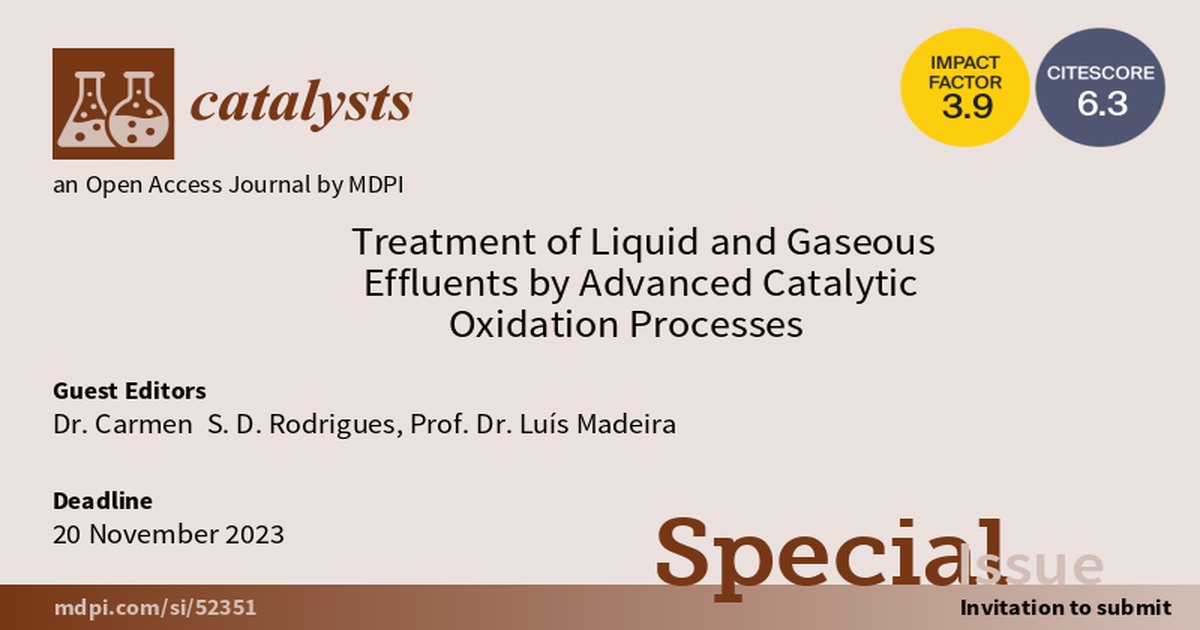Treatment of Liquid and Gaseous Effluents by Advanced Catalytic Oxidation Processes
A special issue of Catalysts (ISSN 2073-4344). This special issue belongs to the section "Environmental Catalysis".
Deadline for manuscript submissions: closed (20 November 2023) | Viewed by 6680

Special Issue Editors
Interests: wastewater treatment; gas stream treatment; homogeneous and heterogeneous Fenton and photo-Fenton catalysts; persulfate oxidation; catalytic wet peroxidation; combining advanced oxidation processes (AOPs) with biological degradation and/or coagulation/flocculation processes.
Special Issues, Collections and Topics in MDPI journals
Interests: multifunctional reactors; membrane reactors; hybrid adsorption–reaction processes; CO2 capture and valorization; H2 production and purification
Special Issues, Collections and Topics in MDPI journals
Special Issue Information
Dear Colleagues,
The treatment of liquid and gaseous effluents for the abatement of refractory, non-biodegradable, and/or toxic organic and inorganic pollutants and/or inactivation of pathogenic microorganisms, especially those resistant to antibiotics, are priorities nowadays, with the goals of minimizing their negative effects on the environment and preserving public health. Advanced oxidation processes (AOPs) are responsible for the partial or total elimination of these contaminants and microorganisms through their oxidation by the highly oxidative radicals that are formed. Such radicals are generated from different species, including hydrogen peroxide, oxygen, ozone, chlorine, and persulfate (among others), particularly through catalyzed processes or by the simple use of radiation. The application of such technologies has shown promise in the decontamination of liquid and gaseous effluents and the inactivation of bacteria and viruses. For this Special Issue of Catalysts, we encourage you to submit an original research article or review paper that focuses on any AOP and addresses at least one of the following issues:
- abatement of organic pollutants in water/wastewater;
- treatment of gas streams containing organic or inorganic contaminants;
- application of AOPs in the disinfection of water/wastewater;
- new catalysts or photocatalytic materials for the removal of pollutants;
- catalyst or semiconductor materials for the inactivation of pathogenic and antibiotic-resistant microorganisms.
Dr. Carmen S. D. Rodrigues
Prof. Dr. Luis M. Madeira
Guest Editors
Manuscript Submission Information
Manuscripts should be submitted online at www.mdpi.com by registering and logging in to this website. Once you are registered, click here to go to the submission form. Manuscripts can be submitted until the deadline. All submissions that pass pre-check are peer-reviewed. Accepted papers will be published continuously in the journal (as soon as accepted) and will be listed together on the special issue website. Research articles, review articles as well as short communications are invited. For planned papers, a title and short abstract (about 250 words) can be sent to the Editorial Office for assessment.
Submitted manuscripts should not have been published previously, nor be under consideration for publication elsewhere (except conference proceedings papers). All manuscripts are thoroughly refereed through a single-blind peer-review process. A guide for authors and other relevant information for submission of manuscripts is available on the Instructions for Authors page. Catalysts is an international peer-reviewed open access monthly journal published by MDPI.
Please visit the Instructions for Authors page before submitting a manuscript. The Article Processing Charge (APC) for publication in this open access journal is 2200 CHF (Swiss Francs). Submitted papers should be well formatted and use good English. Authors may use MDPI's English editing service prior to publication or during author revisions.
Keywords
- advanced oxidation processes;
- heterogeneous catalysis;
- photocatalysis;
- water/wastewater treatment;
- gaseous effluent treatment;
- removal of organic and inorganic pollutants;
- disinfection.
Benefits of Publishing in a Special Issue
- Ease of navigation: Grouping papers by topic helps scholars navigate broad scope journals more efficiently.
- Greater discoverability: Special Issues support the reach and impact of scientific research. Articles in Special Issues are more discoverable and cited more frequently.
- Expansion of research network: Special Issues facilitate connections among authors, fostering scientific collaborations.
- External promotion: Articles in Special Issues are often promoted through the journal's social media, increasing their visibility.
- Reprint: MDPI Books provides the opportunity to republish successful Special Issues in book format, both online and in print.
Further information on MDPI's Special Issue policies can be found here.






